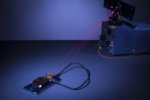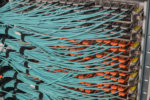Light-carrying, miniature wires are potentially more efficient for computing than other forms of interconnects, including copper and larger optical systems, say experts.
However, there’s been a problem in getting such a nanowire system to work, the University of North Carolina at Chapel Hill, explains in an article published on Science Daily.
“There hasn't been a controlled method for selectively sending light down along nanoscale wires,” says James Cahoon, a professor in the College of Arts and Sciences. “Optical technology has either used much larger structures or wasted a lot of light in the process.” Creating light uses power, defeating the object, for one thing.
At issue is that there needs to be a way to turn on and off light colors in nanoscale — the wires required for optical computing are around 1,000 times smaller than a human hair. That illumination is needed to replace the traditional electrons that zoom along normal copper wires. Alternatively, one needs to miniaturize the light used in common, existing, large-scale optical cables — same end game.
The UNC team said it has figured out a way to accomplish the task. The group says it's fashioning complicated shapes within the nanowires. They then use a breakthrough form of modulation to precisely guide the light. It’s all called Encoded Nanowire Growth and Appearance through VLS and Etching (ENGRAVE) and uses a technique called Mie Resonance. They claim it “will enable downsizing of the optical components.”
It’s revolutionary: Computers, ultimately, will be able to be based on light instead of on electricity, they reckon. In this case, a “new type of nanoscale ‘light switch’ is able to turn on and off the transmission of one color of light over very long distances.”
The school’s invention, covered in Nature Communications, is just one of a slew of attempts being made by engineers to get rid of copper in computing and replace it with photon mediums. Copper wire is inefficient, is slow, carries less bandwidth, creates more signal loss (attenuation), is easily breakable, and is prone to interference.
Other options for light-based computers
Light-based laser silicon chips, too, are an angle in the drive towards light computers. Using laser instead of copper wires in chip design allows more data to be sent, reducing bottlenecks, scientists say. Also, less power is needed, and as an added benefit, silicon-germanium (what makes up chips) has some light absorbing functionality on its own. In fact, growing the laser directly on the chip’s silicon substrate would get the data out to the electronics faster than anything before.
Graphene, too, might one day be incorporated into optical computing. Experiments are taking place where electrical fields are being used to boost optical effects of the bonded carbon atoms in the wonder material.
That “could enable [controlled] on-chip broadband optical switches for data transport in optical systems,” with ultra-broad bandwidth “enabling a larger volume of information to be processed or transmitted," Graphene Flagship said on its website in May.
“Swapping electrons for light-based technology would mean that the computers of the future won't overheat and will run much faster,” UNC says.
Data centers won’t require as much cooling, for example. Optical computing technology “would alleviate the bandwidth and energy consumption limitations of current technologies.”




